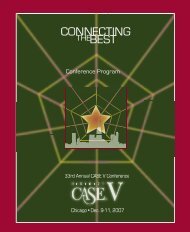Chapter 1 Why People Respond to Fundraising Letters - CASE
Chapter 1 Why People Respond to Fundraising Letters - CASE
Chapter 1 Why People Respond to Fundraising Letters - CASE
Create successful ePaper yourself
Turn your PDF publications into a flip-book with our unique Google optimized e-Paper software.
<strong>Why</strong> <strong>People</strong> <strong>Respond</strong> <strong>to</strong> <strong>Fundraising</strong> <strong>Letters</strong> 15society otherwise ignores or undervalues. Don ’ t think just of the privateschools and colleges, nonprofit hospitals, museums, and symphony orchestras.Think about Mothers Against Drunk Driving, Disabled American Veterans,Planned Parenthood, the Nature Conservancy, and the hundreds ofthousands of other organizations like them that are far less well known.Often these organizations are on the front lines of research or public debateon the most challenging, the most controversial, the most engaging issues.If that ’ s true of your organization, the emphasis you place in your appealon your special knowledge may help motivate donors <strong>to</strong> give.Your donors may even perceive the appeal itself as a benefit. As researchfrequently reveals, donors regard the letters they receive from charities asa source of special knowledge. I believe that helps explain why long letterscontaining hard facts and intriguing ideas often outpull more emotionalappeals.16. <strong>People</strong> send money because you help them preservetheir worldview by validating cherishedvalues and beliefsThe very act of giving affirms a donor ’ s dedication <strong>to</strong> a charity ’ s worthyaims. Donors support your organization ’ s work because you act on theirbehalf, pursuing your mission with time and effort they could never bring<strong>to</strong> bear themselves. In this passionate pursuit, you act out their values andbeliefs — the deep - seated convictions that lead them <strong>to</strong> join in your mission.But you must constantly remind them of the connection.If your organization ’ s mission is congruent with widely shared valuesand beliefs — a commitment <strong>to</strong> piety, for example, or saving dolphinsor promoting efficiency in government — you face an obvious marketingopportunity. But if your nonprofit is dedicated <strong>to</strong> an unpopular cause, suchas prisoners ’ rights, you possess a similar (if unenviable) advantage: forthat small number of donors willing <strong>to</strong> take a stand on an issue that othersreject, the values and beliefs that make the act of giving a form of personalaffirmation suggest <strong>to</strong> the fundraiser a language both may speak.17. <strong>People</strong> send money because you allow them <strong>to</strong> gainpersonal connections with other individuals who arepassionately involved in some meaningful dimension of lifeA charity is an intentional community of sorts — a cooperative venture, aninstitutional expression of a shared creed or common hopes. Your job asa fundraiser is <strong>to</strong> strengthen the bonds that tie your community <strong>to</strong>gether.
















